#this is what i was talking about re: earlier ask re: the output of pop history
Explore tagged Tumblr posts
Text
"Sir Edward Seymour's rise to a position of influence was swift: [...] [in 1536] he was shortly to be made Master of the Horse, [bringing him] into daily contact with the King [...]"
The expences of my Lord [the Duke of Richmond]'s household, July 1525 To Sir Edwd. Seymour, master of the Horse, for horses,&c., 60l
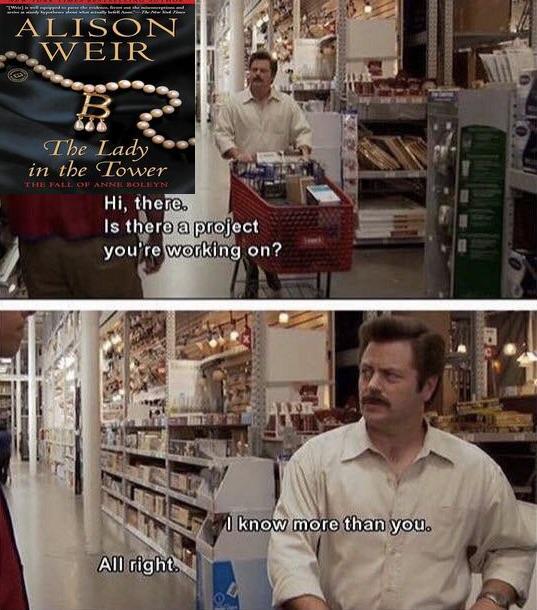
I've noticed that I catch way more errors reading pop history books than I do when I listen to their audiobook counterparts...
#carew was master of the horse until his execution. the position then went to sir anthony browne#and william coffin continued as the queen's so idk where she even got this ......other than maybe reading this in the archives and#both confusing the date and/or not checking whose household account it was lol#this is what i was talking about re: earlier ask re: the output of pop history#it's not to say historians don't have deadlines as well but they're (rightly) under a lot more scrutiny to be meticulous and thorough#in their fact checking#but anyway i still clocked this. even just listening to this while folding laundry...#i ran out of fiction i wanted to listen to and idk ...i felt like judging lol#also i have a ton of hours left in my spotify limit and they refuse to let you have 'rollover' hours#(ie if you don't max out your audiobook hours on your monthly membership you don't get that added to the next month)#which makes me furious...
8 notes
·
View notes
Link
I'm slightly disappointed to log onto Zoom and find Gwen Stefani in Los Angeles. I wanted to see the ranch. Stefani spent most of the pandemic in Oklahoma with her fiancé and fellow The Voice coach Blake Shelton, with whom she has recently collaborated on a string of country radio hits, alongside a kitsch Christmas song. For a ska-pop superstar, it's a pivot, but Stefani and Shelton are cute together — picture-perfect in their opposite attraction.
Country Gwen exists, her urban counterpart assures me, but on this particular MacBook she's nowhere to be seen. I'm not sure what crude regional stereotypes I was expecting (Stefani spitting sunflower seeds? Shelton line dancing in the background?) but I get Californian sunshine instead, illuminating a version of Stefani more familiar from my teenage years, when Love. Angel. Music. Baby and its follow-up The Sweet Escape spawned millions of fans, haters and imitators. She's platinum blonde, red lipsticked and wearing a black-and-white outfit that matches the decor. The checkerboard pattern can be traced back to an even earlier era, when Stefani and her No Doubt bandmates were '80s teenagers obsessed with two-tone acts like Madness and The Specials.
Cowboy boots wouldn't fit this picture, and nor would Stefani's glitzy showgirl outfits from The Voice, where she just wrapped another season as a celebrity coach. As she prepares to release her fourth solo record, and enters the fifth decade of an extraordinarily successful music career, Gwen Stefani is re-re-branding as... Gwen Stefani.

Top: Local Boogeyman, Pants: GCDS, Shoes: Valentino, Earrings, bracelets and rings: Dena Kemp (The Residency Experience), Necklaces: Gwen's own, Engagement ring: Gwen's own
"But what is that?" Stefani asks with seriousness, as we consider the possibility of some essential, inherent Gwen. "Everyone's interpretation of what I am and how I sing, I mean, that's what this era is about for me."
Said era kicked off late last year, with the music video for "Let Me Reintroduce Myself." It saw Stefani playfully revisit the wardrobes of album cycles past, from the ab-bearing tomboy tank tops of "Hollaback Girl" to the club kid blue hair mascara of '90s No Doubt. Her Harajuku Girls also make a return. The entire visual is a huge flex, not only for the sheer volume of iconic career moments recreated in dutiful detail, but the fact Stefani can still fit into the clothes originally worn during all of them. She looks eerily the same, frighteningly good, ageing in reverse at the same pace as her frequent collaborator Pharrell.
"It's really a blessing to be able to have such a long career, where there really is nothing to prove anymore."
Pop stars are expected to be young forever, in looks but also in their capacity to innovate new trends. Which makes the nostalgic music video a curious choice. Doesn't Stefani know by now that the cardinal rule of pop is to avoid repeating yourself? That even the hottest artists in the world are basically required by law to create completely new eras from scratch every six months in order to appease fans and maintain maximum TikTok-ready relevance?
Of course she does, but that doesn't mean she has to participate. Stefani isn't trying to chase down her contemporaries, despite clearly possessing the physical fitness required. "It's really a blessing to be able to have such a long career, where there really is nothing to prove anymore," she says. "It's a different energy. You know, it's really just about doing it to do it, as opposed to trying to make a statement or make a mark."
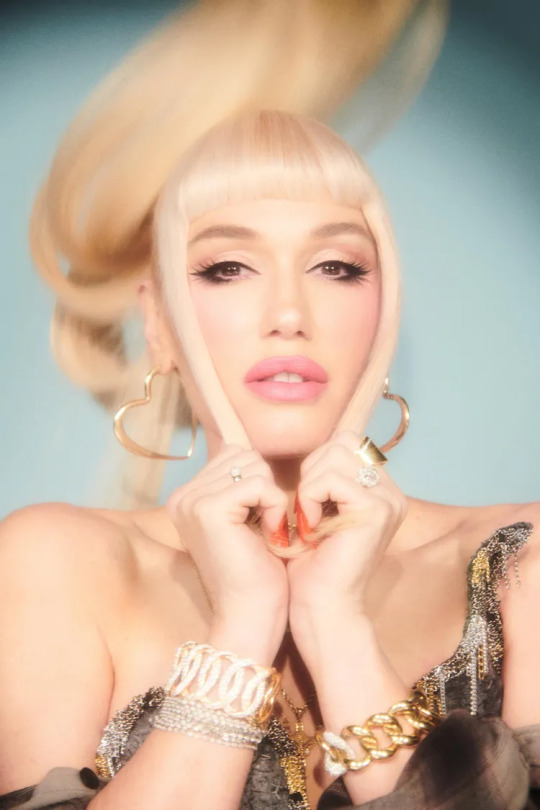
Corset: Ronald van der Kemp, Bracelets: Dena Kemp (The Residency Experience), Earrings: Lana Jewelry (The Residency Experience), Engagement ring: Gwen's own
Even the Saweetie remix of her latest single "Slow Clap" happened on a whim, after the younger artist happened to post a video of herself vibing to Stefani's 2004 single "Luxurious" on Instagram Stories. They knocked out the song and accompanying video in a day. Neither seems bothered by the Old Navy meme. "It was just this little video that we did on the fly," Stefani says. "It just happened. It just feels good to put new stuff out there."
Stefani completed a two-year Vegas greatest hits residency in 2019, which gave her a sense of perspective on her own legacy. "You make a new record because that's what is exciting for you," she says. "But people really just want to hear the records after a while that were the backdrop to their lives, a 'Don't Speak' or a 'Just a Girl' or a 'Hollaback Girl,' or whatever it was for them. So, you know, it's hard — you can only be new when you're new, and that's just the truth, and I know that."
She says she was pleasantly surprised that "Let Me Reintroduce Myself" charted at all, and that she only found out it did when Shelton walked into the kitchen to show her the iTunes numbers. "I burst out crying with joy, because it was like, 'Whoa, really?' I think I'd set myself up to be quite realistic about where I'm at."
Stefani, endlessly polite and self-deprecating in conversation, which on her end mostly consists of endearingly earnest run-on monologues, says she still has "tons" of insecurities. I get the impression she has been trying harder to give herself credit lately. She recalls recently hearing Cyndi Lauper's "Girls Just Want to Have Fun" on the car radio and finding herself in awe of the song's timeless catchiness.
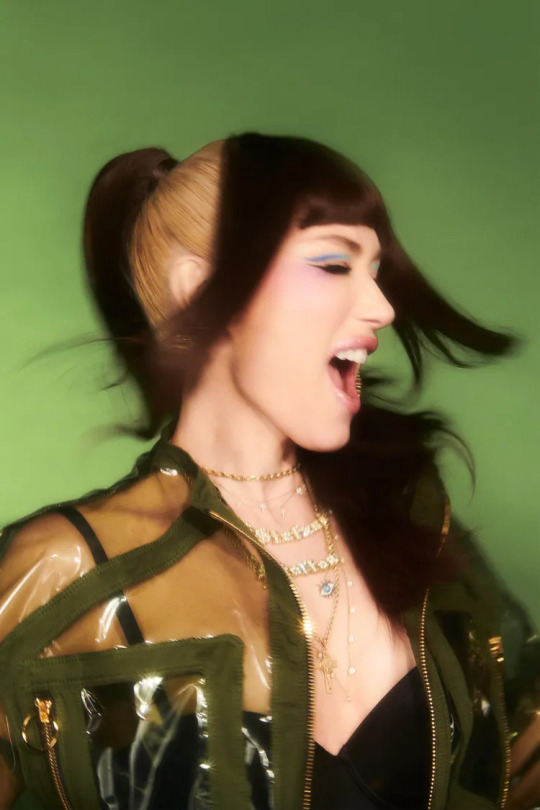
Suit: Balmain, Earrings and choker: Lana Jewelry (The Residency Experience), Necklaces: Gwen's own
"But then I started thinking," she says, in a goofy Cher Horowitz tone. "Like, I have a few of those myself." She talks of this realization as a genuine breakthrough, which is a little worrying for a woman who has sold 40 million records. No shit, she has a "few of those." More of them than Lauper, actually.
More new music is coming along slowly, but I've caught Stefani on a day when the horizon looks closer than usual, and while things haven't quite fallen into place yet, she's feeling more confident that they eventually will. "I'm at the end," she declares. "The idea of going for a session and not being with my kids or the idea of taking time away from Blake doesn't fuel my fire like it did two months ago. I need to decide, wrap it up, put out the project."
Crucially, there's no rush. The album will simply arrive sometime this year, tracklist and title currently undecided.
"You're talking to me at a weird transitional time," Stefani says repeatedly throughout our conversation, which sometimes takes on the cathartic tone of therapy. But having time in the first place is a new feeling.
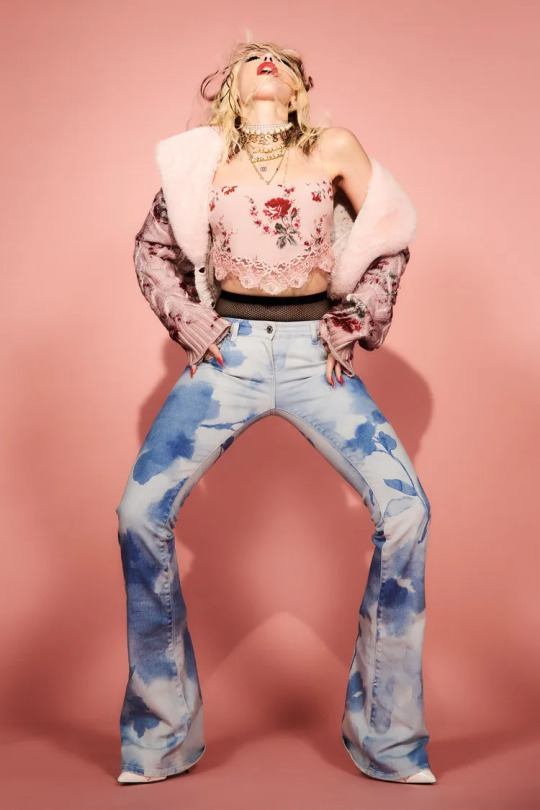
Bracelet and choker: Dana Kemp (The Residency Experience), Obsession necklace: Lidow Archive, Gold necklaces: Gwen's own, Clothing: Blumarine, Boots: Philipp Plein
NO DOUBT WERE A BAND for nine years before getting on the radio. Enough time for Stefani and bassist Tony Kanal to be in a long term relationship then break up and write a whole hit album about it. All of the Fleetwood Mac drama was resolved pre-fame, which enabled the group to capitalize on the surprise success of Tragic Kingdom singles like "Don't Speak" and "Just a Girl" with a world tour that lasted almost three years. Three more albums followed, and Stefani has reinforced her household name status in every decade since, launching a solo career and multiple fashion lines while never totally cutting the cord from her original musical project.
In other words, record executives have been dictating Stefani's schedule since the mid-'90s. She even sings about it on Love. Angel. Music. Baby opener "What You Waiting For," in which her biological clock ticks like a metronome. Interscope Co-Founder Jimmy Iovine, who discovered No Doubt and continued to work with Stefani on her solo output, was quick to point out that his client's prime childbearing years were also her last opportunity to cross over into pop stardom. And after her first record went number one, it only made sense to lay down some new tracks straight away.
"Whether or not I get the response that I would hope to get — because that's what I'm used to, because I'm so damn spoiled and I've tasted the blood of success — I still got to do the creative journey."
"I had the baby, the first one, and it was only like eight weeks after I had him, that Jimmy was calling me saying, you've got to go in the studio with Akon," Stefani recalls cheerfully. "Like, Akon wants to work with you. Like, no, I'm nursing my baby. But then I couldn't say no." And then? "We wrote 'Sweet Escape.'" And then? "I went on a world tour." And then? "In the month that I got home from that one hundred and whatever shows it was, I got pregnant with Zuma. So then that was that." (It wasn't. Admittedly: "Then it was like, No Doubt, let's do another record.")
Things are different now: "You can just drop singles and you don't have to put a record out. But if you want to put a record out, you can work on it slowly." But even as she talks of slowing down, speculating that she might not even go on tour after the pandemic ends, in the next sentence Stefani's back to admitting that there's more work to be done, that she wants to write a couple more songs for her new record, "just to make sure."
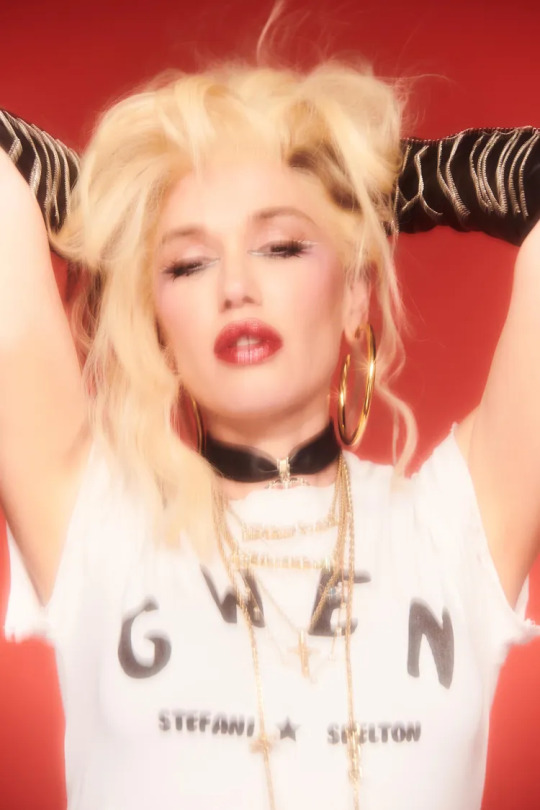
Earrings: Lana Jewelry (The Residency Experience) Choker: Chanel, Necklaces: Gwen's own, Gloves: Laurel DeWitt, Top: Local Boogeyman
"The creation is the thing that fuels me so much," she says. "Whether or not I get the response that I would hope to get — because that's what I'm used to, because I'm so damn spoiled and I've tasted the blood of success — I still got to do the creative journey."
Like any good lyricist, she reaches out to her listener, hoping to convey a more universal point. "It's just probably the same for you as a writer," she guesses. "You know, it's the anticipation. You're in it now. You're getting the information. This is what you live for. You're doing the interview and then you're going to write it. And that's going to be the challenge."
GWEN STEFANI WAS PUTTING out diary entry pop when Olivia Rodrigo was still in diapers and Taylor Swift was but a humble Pennsylvania Christmas tree heiress. She struggles to pen lyrics that aren't confessional ("I'm not a creative writer when it comes to like, 'Oh, let's just write a sad song about something that didn't happen to me'"), and occasionally re-traumatizes herself when performing old hits. Return of Saturn deep cut "Dark Blue" triggers "crazy, just horrible" recollections of a past relationship. Even "Don't Speak" felt emotional onstage in Vegas.
But after releasing an excruciating divorce album, This Is What the Truth Feels Like, in 2016, Stefani is back to writing happy songs only. She's getting married, after all. She won't be releasing any of her trademark breakup anthems anytime soon. "Girl," she laughs, "I think I've had my fair share."
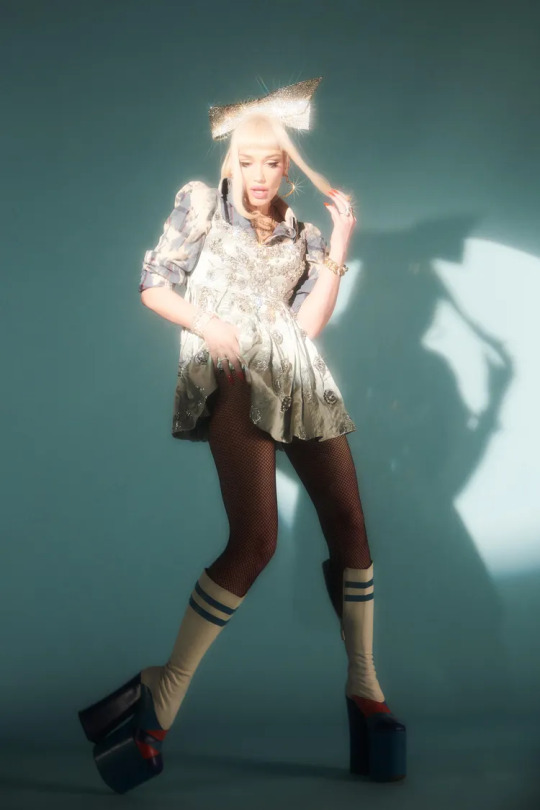
Bow: Laurel DeWitt, Earrings: Lana Jewelry (The Residency Experience), Bracelets: Dena Kemp (The Residency Experience), Shirt: Vintage Archive, Dress: Erdem, Tights: Capezio, Shoes: Marc Jacobs (Lidow Archive)
Stefani and Shelton's relationship has puzzled some fans. Shelton, a country radio phenomenon, never endorsed Trump in the 2016 election, but he did come close. Earlier this year, he was criticized for releasing a song called "Minimum Wage," about finding small joys during periods of economic struggle, at the peak of a recession.
Is Gwen Stefani a Republican now? She's not offended by the question, or really anything I have to ask. She has been famous for so long that she expects and even embraces scrutiny. "If you're going to be a star, that's what you get," she says. "You know what I mean? You get what you get, and you don't get upset, at all."
As for her politics, it's read-between-the-lines."I can see how people would be curious, but I think it's pretty obvious who I am," she says. "I've been around forever. I started my band because we were really influenced by ska, which was a movement that happened in the late '70s, and it was really all about people coming together. The first song I ever wrote was a song called 'Different People,' which was on the Obama playlist, you know, a song about everyone being different and being the same and loving each other. The very first song I wrote."
One of very few multi-racial bands playing stadium shows for hoardes of American teenangers in the 1990s, No Doubt did very literally embody those second-wave ska principles of inclusion. Stefani even wore bindis and saris on stage as a symbol of cultural exchange with Kanal, who is Indian-American, briefly kickstarting a white girl facial jewelry trend that it's safe to say would not fly in 2021.

Rings (left): Dena Kemp (The Residency Experience)
"The Specials and The Selecter and all those groups, and what they were doing in the late '70s was this whole kind of anti-racism, we come together, Black and white ska movement," Stefani elaborates on the band's founding principles. "And we were sort of echoing that in the '80s when we did it, we were like the third generation of ska."
Ska she's always happy to discuss, but Stefani was brought up to keep her electoral preferences personal, and that rule has held for her entire career. "The whole point of voting, is you have this personal space to feel how you feel," she explains. "I use my platform to share my life story and to engage with people and to exchange whatever gift I was giving. I'm not a political science major. I am not that person. Everyone knows that. So why would I even talk about it?"
"I don't need to go on Instagram and say 'girl power.' I just need to live and be a good person and leave a trail of greatness behind me."
It never has been. Looking back, it's weird that "Just a Girl" is so integral to Gwen Stefani's brand. She's never written anything else with remotely the same message, and or publicly identified as a feminist. To Stefani, it's just a song about growing up, and "all of a sudden you realize your gender." It wasn't meant as a protest or anthem: in fact, being her breakout hit, she didn't think anyone other than her bandmates and some local fans would ever hear it.
"I don't even know if I knew what feminist at that time was," she says. "I was very sheltered growing up with my family. I wasn't political. I wasn't angry." Even now: "I don't need to go on Instagram and say 'girl power.' I just need to live and be a good person and leave a trail of greatness behind me. Stop talking about it and stop trying to bully everybody about it. Just do it. And that's how I feel like I've lived my life."
WHEN STEFANI WAS GROWING up in 1970s Anaheim, her father got a job doing market research for Yamaha, which required frequent business trips to Japan. He'd bring home Sanrio toys, as well as anecdotes about the Tokyo district of Harajuku, where teenagers were dressing like Elvis, and "taking all these American things and making them Japanese." His daughter was entranced. "He would be telling me these things my whole life, like my whole life. I had a deep fascination."
So when No Doubt played Japan in 1996, Stefani describes, "It was a pretty big deal for me." The tour was the first time she'd traveled outside of the United states, save one trip to Italy when she was 21. "I just was inspired," she recalls. "It's a world away. And at that time it was even further, because you couldn't see it on the internet. I don't think a younger generation can even imagine what it's like to not have access to the world."
From then on, Japan became one of Stefani's biggest career motivations, especially when it came to her solo albums. If she could just write more hits, she'd get to tour there again, see the street style, visit the vintage stores. "If you read the actual lyrics [in 'What You Waiting For?'], it talks about being a fan of Japan and how if I do good, I get to go back there," she says.
In the meantime, she decided she'd bring Japan to Los Angeles. "I never got to have dancers with No Doubt. I never got to change costumes. I never got to do all of those fun girl things that I always love to do. So I had this idea that I would have a posse of girls — because I never got to hang with girls — and they would be Japanese, Harajuku girls, because those are the girls that I love. Those are my homies. That's where I would be if I had my dream come true, I could go live there and I could go hang out in Harajuku."
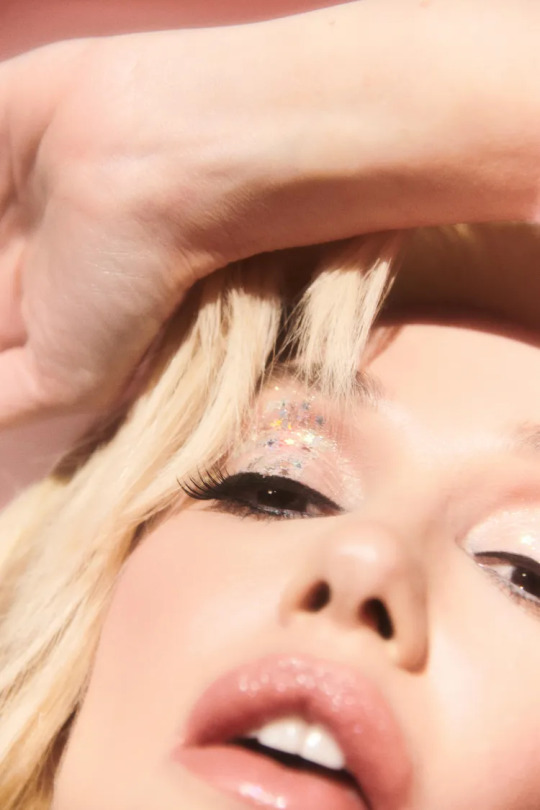
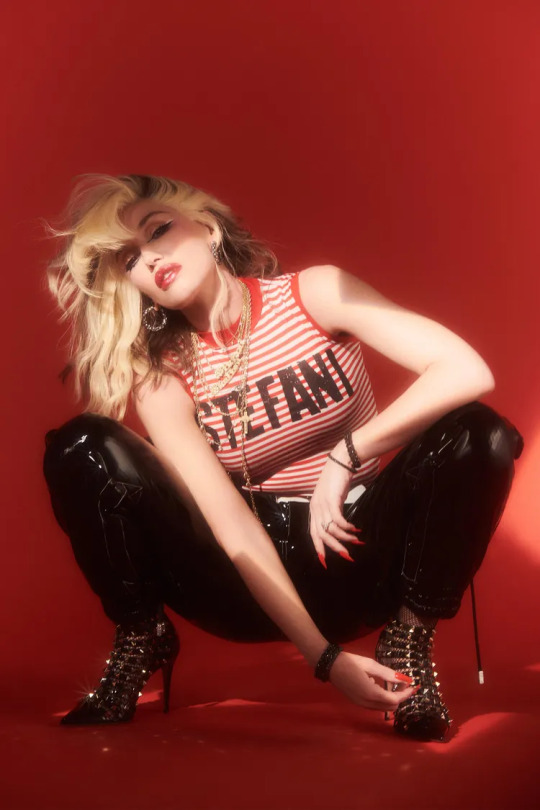
Earrings, bracelets and rings: Dena Kemp (The Residency Experience, Gold Necklaces: Gwen's own, Top: Local Boogeyman, Pants: GCDS, Shoes: Valentino
Dancers Maya Chino ("Love"), Jennifer Kita ("Angel"), Rino Nakasone ("Music") and Mayuko Kitayama ("Baby") would go on to accompany Stefani for her next two album cycles, dancing on stage and in her videos while also making silent, but very well-dressed, awards show appearances. Kita, who'd grown up in LA, visited Japan for the first time on Stefani's tour.
In a 2006 interview with Blender magazine, comedian Margaret Cho compared the Harajuku Girls to a minstrel show. The backlash against them has been consistent ever since. Stefani, to this day, disagrees.
"If we didn't buy and sell and trade our cultures in, we wouldn't have so much beauty, you know?" she says. "We learn from each other, we share from each other, we grow from each other. And all these rules are just dividing us more and more."
Hello Kitty merch was harder to come by when she was a kid, but in other ways, life felt easier. "I think that we grew up in a time where we didn't have so many rules. We didn't have to follow a narrative that was being edited for us through social media, we just had so much more freedom."
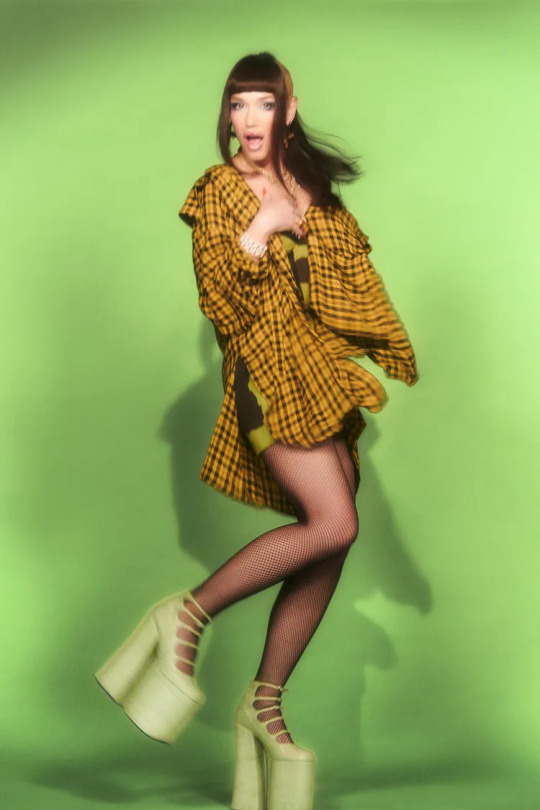
Earrings, bracelets and rings: Dena Kemp (The Residency Experience), Necklaces: Gwen's own, Dress: GCDS, Shirt: Faith Connexion, Tights: Capezio, Shoes: Marc Jacobs (Lidow Archive)
Stefani's penchant for rule breaking has always been apparent in her music as much as her aesthetic. Genre-wise, she's a randomista. The chart success of No Doubt's bouncing ska beats felt like an accidental post-grunge-era glitch in the matrix, and it's insane to this day that one of Stefani's biggest solo hits samples "If I Were a Rich Man" from Fiddler on the Roof, by way of '90s British dancehall duo Louchie Lou & Michie One. That another, "Wind It Up," features earnest Sound of Music yodeling.
"I just make up whatever comes out," Stefani says of her songwriting process. "I don't even know where it comes from. I feel like it just comes from the source. It's not trained, and it's not perfect, it's just real."
She looks back on the Love.Angel.Music.Baby era as unusually experimental and artistically fulfilling. "It was just a really incredible time, and a very creative time. I feel like it was just a really creative project."
STEFANI VIEWS HER CAREER success as mostly a matter of luck. Pop stardom is God-given and mysterious."Because the fact I made it, it doesn't make any sense," she reflects. "It's written in the stars. You know what I'm saying? I'm not the most talented. I'm not the most pretty. I'm not the most smart. None of those things. But I made it, right?"
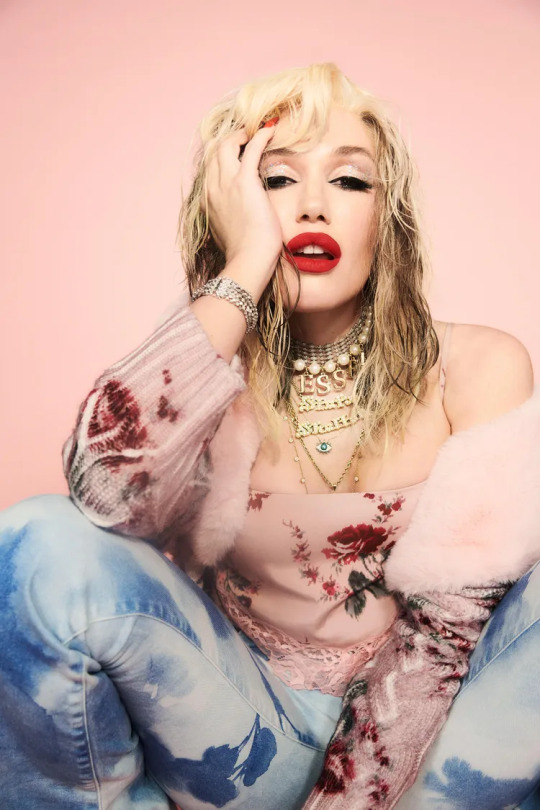
Clothing: Blumarine, Bracelet and choker: Dena Kemp (The Residency Experience), Obsession necklace: Lidow Archive, Gold necklaces: Gwen's Own
Every week on The Voice she watches objectively gifted musicians fail at becoming artists. "I watched people that went through that without seeing their faces, without knowing what color they are. And I chose the ones that pulled my heartstrings. And even though they were so talented, none of them have had careers. It's made me look at myself and even feel even more amazed by the fact that anyone cared or cares."
If all of this is actually so out of her control, then Stefani feels safe stepping back a little bit. "I don't have that fuel in me like I used to, because I already won," she says. And now she has other victories in mind. "Being a good human, a good mother. I want to have a good marriage. I want to be a good wife. I want to win at finding peace. I want to win at finding other hobbies that I'm good at."
But at the same time? "If I'm inspired, I'm going to try to do something with that inspiration." That's the most fun part: whatever else comes after has always been an amazing bonus.
The "Let Me Reintroduce Myself" era, whatever form it may eventually take, isn't a desperate grab at former glory. It's Stefani refusing to evolve for the sake of it. She's poking fun at the whole idea of having to compete with past personas alongside current ones, while acknowledging the fact she's grateful to still be in the game at all.
"You don't know what you're doing," she says, somehow both confident and resigned. "You're a cartoon of yourself at this point, and you don't know what people are thinking. They're wondering, what? Why are you still here? And I'm like, I don't know. They said I could be here. So I'm here!"
Photography: Jamie Nelson Styling: Nicola Formichetti Hair: Sami Knight Makeup: Michael Anthony Nails: Carolyn Orellana Wardrobe director: Marta Del Rio Production: Katrina Kudlick Digitatech: Sean MacGillivray Logo design: Luca Devinu Story: Kat Gillespie
FROM YOUR SITE ARTICLES
14 notes
·
View notes
Text
Clean White Research
The clean white brief is about taking studio portraits on a clean, white background. While studying NC5 photography last year, I was taught the best way to achieve a bright white background was to point 2 lights, left and right, angled onto the middle section of the backdrop. I adjusted the lights until they were registering F11 on the Sekonic light meter. Next, I would place my model approximately 2m in front of the backdrop (to avoid shadows from the front lighting) and set my lighting up to measure F8 under the model’s chin.
My lecturer suggested researching photographers who used this kind of set up and my findings are below.
David Bailey

David Bailey by Ben Hassett bromide print, 2014
David Bailey (1938-), Photographer and film-maker
“Graduating from being an assistant with fashion photographer John French in 1959, Bailey began the 1960s with a contract with Vogue to become the decade's iconic chronicler with two defining portrait publications David Bailey's box of pin-ups (1965) and Goodbye Baby and Amen (1969). They focussed on a new social order that evolved from the decade of change. Bailey was a leading figure in the Swinging Sixties London scene and provided some of the inspiration for the role of the photographer, played by David Hemmings, in Antonioni's cult film Blow Up (1966.) Bailey had his first Museum exhibition at the National Portrait Gallery in 1971.”
Source: https://www.npg.org.uk/collections/search/person/mp05044/david-bailey
Famous Portraits by David Bailey
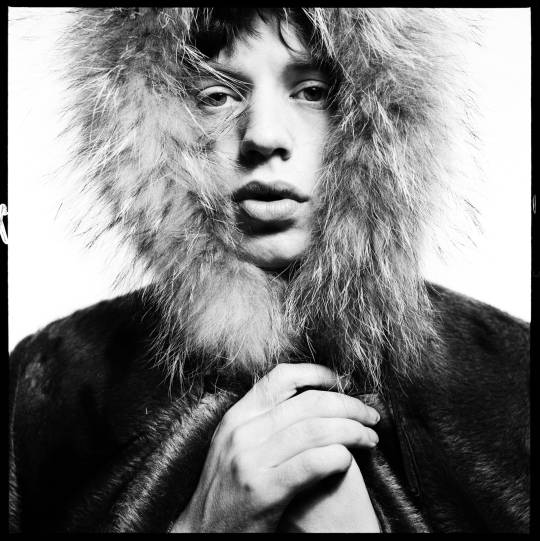
Mick Jagger, 1964

Kate Moss, 2013

Damon Albarn, 2007
Source: https://www.theguardian.com/artanddesign/gallery/2014/feb/05/national-portrait-gallery-david-bailey
Richard Avedon

“Richard Avedon was an American fashion and portrait photographer. An obituary published in The New York Times said that "his fashion and portrait photographs helped define America's image of style, beauty and culture for the last half-century".
Source: https://en.wikipedia.org/wiki/Richard_Avedon
Famous Portraits by Richard Avedon

Katharine Hepburn, actor, New York, March 2, 1955

Martin Luther King, Jr. with Father and Son, 1963
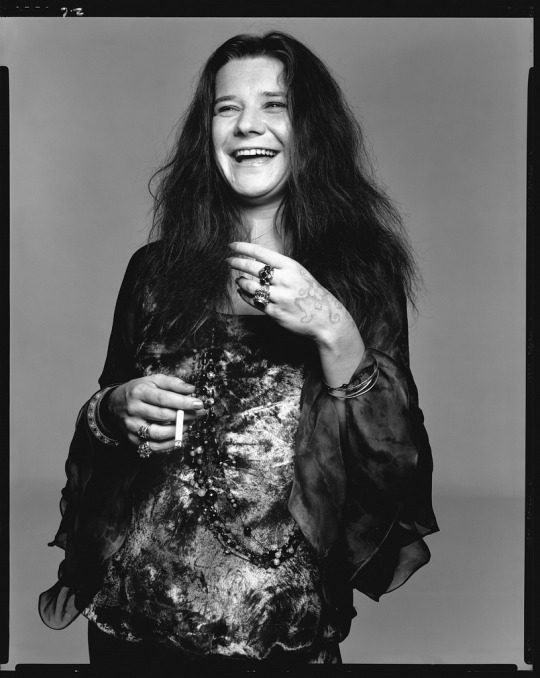
Janis Joplin, singer, Port Arthur, Texas, August 28, 1969
Irving Penn

“Irving Penn (June 16, 1917 – October 7, 2009)[1] was an American photographer known for his fashion photography, portraits, and still lifes. Penn's career included work at Vogue magazine, and independent advertising work for clients including Issey Miyake and Clinique. His work has been exhibited internationally and continues to inform the art of photography.”
Source: https://en.wikipedia.org/wiki/Irving_Penn

Marlene Dietrich, New York, 1948

Vogue cover shot, 1950


Salvador Dalí, New York, 1947
Tips from the web...
4 Tips for a Perfect White Background in High Key Photography
A guest article by Tony Northrup.
A bright, white background creates a high energy, happy, and distraction free scene, perfect for pictures of your friends and family. Known as high key photography, this technique instantly cures problems with ugly backgrounds and focuses the viewer’s attention on your subject.
Besides being a popular for portrait photographers, it’s a more modern choice, rather than traditional (ie., painted muslin). Here are my favourite tips for creating high key photos.
4 tips for perfect white backgrounds in high key photography
Tip #1 – Use a Solid White Background to Eliminate Distractions
I used a big, white piece of paper as the background for this portrait of my twin nieces because anything natural for a background would have clashed with their colourful outfits. The brightness also perfectly matches their expressions.

Tip #2 – use sunlight as your background
To create a solid white background, you need to completely overexpose your background without overexposing your subject. That means you’ll need much more light on your background than on your foreground subject; about 16 times more light (or four stops of light).
Fortunately, we all share a very powerful and free light source: the sun. For this photo of a radio talk show host and his dog, I had him kneel in my kitchen at midday when the sun was streaming through the glass doors behind him. I added three stops of exposure compensation to properly expose their faces. Because the sunlit background was much brighter than the shade in my kitchen, the camera captured it as solid white.

Tip #3 – use a flash on the background
Another easy way to create a bright background is to light it with an off camera flash. Simply move your model four to six feet away from your background and hide a flash behind your model, pointing it at the background. When you take your photo, the flash will light the background to overexpose it and make it appear completely white.
An off camera flash doesn’t have to be expensive. Any manual flash with an optical slave will work, including the $60 (US) YongNuo YN-560 that I often use. Simply turn on both the flash’s optical slave and your built-in flash. When you take a picture, your flash will trigger the off camera flash to light the background.
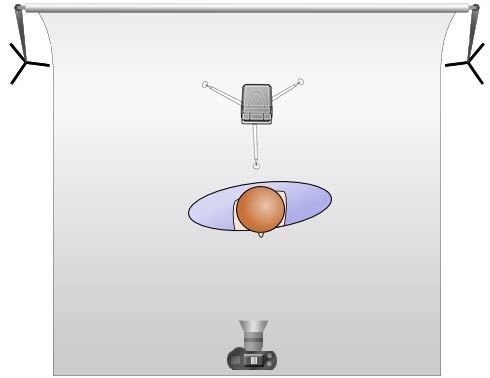
Tip #4 – don’t over, overexpose the background
You can overexpose a high key background too much. If you bounce too much light off your background, the backlighting will overtake your model and wash out your picture. For example, the picture on the left had too much light on the background, while the picture on the right had just the right amount.

To get a perfectly white background without washing out your picture, start your background light at its lowest power and increase it one stop at a time until the background is barely overexposed. In this video, my wife Chelsea and I show you exactly how to find the perfect flash output. Our book, Stunning Digital Photography, includes more than six hour of video integrated into the lessons, because photography is a visual art, and often it’s easier to learn by watching than reading.
Source: https://digital-photography-school.com/4-tips-perfect-white-background-high-key-photography/
Test Shoot with silhouettes and recreating lighting
Today, we set up in the studio to capture our first test shoot for the brief. The lecturer had asked us to bring in a print out of a shot by a famous photographer on a clean white background to try and emulate the lighting and viewpoint. First we set up the backdrop and positioned two lights onto it, left and right, and metered until the left, centre and right sides were all metering at F16. We achieved this by increasing and decreasing the power of the lamps and moving them inwards or outwards until we had an even spread of light. Next we took silhouette shots to make sure the backdrop was evenly lit before we worked on the lighting on the model. The shot I decided to try and emulate was a portrait of Madonna by Herb Ritts.

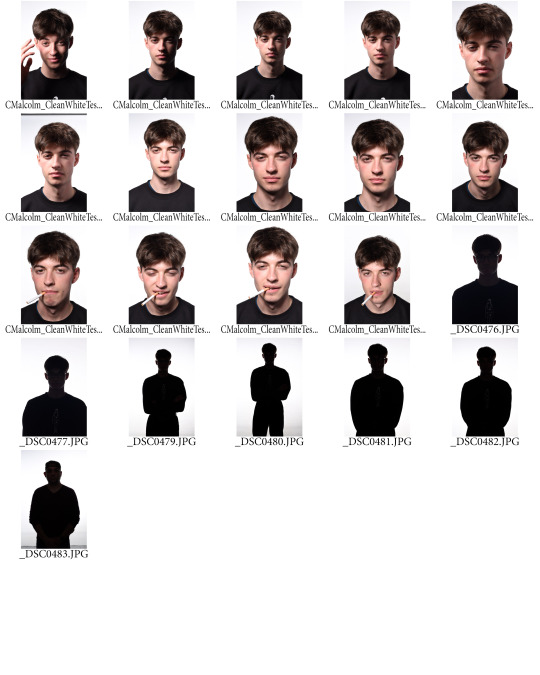
I think we managed to get the correct lighting to replicate the shadows in the final shot and stood on a ladder to get the correct viewpoint.

Shoot 1 - First Attempt
I decided to ask James in the class to be my model and brought in a selection of props to see which would work best. I liked the idea of dressing him either as a hacker, using an “Anonymous” mask to show him as if he is revealing his true identity. I wanted the mood of the shot to be quite dark and mysterious so I used a single light above and slightly to the right go his head and fitted it with a snoot. I also brought in a microphone and a set of headphones as I wanted to see if I could make him into a pop star recording in the studio or maybe paying live to his audience. I think the “hacker” shot worked best so optimised this one and submitted it for a class critique the following Friday.
Contact Sheet from the session

Final shots chosen pre-optimisation


Post optimisation

Final chosen shot optimised and submitted for class critique

On the whole, the critique was quite positive, with comments such as “Love the crop”, “Good contrast” and “Love the lighting rig!” The suggestions were, “Tilt mask to show more” and “More effective without headphones?”, which I agree with as, on reflection, they detract from the mask and suggest he could be a DJ. I did further research before the second shoot and decided to drop the headphones and introduce a hoodie along with a 3″CD I wanted him to point towards the camera as if it contained important data. I also thought the highlights from the CD would work well and balance with the highlights from the mask. The film I shot for this session didn’t come out when I developed it as there was very little front lighting, suggesting the lamp hadn’t been firing, so I’ll re-shoot on film too at the next session.
Second session contact sheet

Shot chosen to be optimised

Evaluation
I think this shot works better than the first one and optimised it using Photoshop in my Imaging class, where I created a B&W layer along with a curves layer and added the black key-line. I asked my model to pose as if asking the viewer to “shhh...”, imagining he had revealed his identity to them personally but still wished to remain “Anonymous” from all but a chosen few. I wanted to frame the shot quite closely to the subjects face and keep his eyes in the right upper third but balance that off with the mask in the bottom left lower third. I also cropped in on the mask tighter than previously as I think the shot works better if the viewer has to work out what the object is. The addition of the hoodie as a prop also lends some mystique to the image and I feel gives a better contrast to the face and makes a more flowing shape to the centre of the shot, taking the viewer’s eye from the subjects eyes down towards the mask. This shot also had the least amount of negative or white space, which I felt there was too much of in the earlier attempts. I think the key to a successful portrait is in the planning and propping of the model along with careful consideration of the framing and shapes and balance within the frame.
1 note
·
View note
Photo

So,
The Friday issue had just arrived.
I’d been at the Star for nearly four years, but I still got giddy whenever the fresh stacks of bundled papers showed up at the office twice a week. I made a ritual out of gathering copies for the entire newsroom, then settling in to read each issue with a large A&W coffee. Sometimes I counted up my stats, like Greg Nesteroff had, always looking to break new records with my output. As far as I was concerned, I was doing the job better than it had ever been done — and I was especially proud of my Me Too column, in which I’d attempted to acknowledge my complicity within rape culture while also expressing my aspiration to be a better human. I felt like I was starting to learn the social justice language of the feminists speaking out on the issue, like I’d built up enough credibility to write something meaningful and contemporary and, most importantly, moral.
I was halfway through re-reading the print version of that column for about the fourth time when Ed’s phone rang. The window beyond his desk gave us a panoramic view of the grey drizzle. He grumbled into the phone, grabbing at his notebook and jotting down some details. I took my feet off my desk and tried to listen in, noting the way his body language had tensed. He sighed heavily, thanked the caller, then sat for a long moment staring at his lap.
“So?” I asked. “What was that?”
He grimaced in my direction. “We’ve got another fentanyl overdose.”
“When? Where? Who told you this?”
“Young girl, teenager. The caller’s a friend of the family, apparently. He was really upset, said somebody needs to speak up about this.”
I stood up and walked over to his desk. “He said that? Does he want to go on record with us? Did you get a name for the girl?”
He picked up his notepad, looked through the glasses perched at the end of his nose, frowned. “Kessa Cunningham, he said. Do you know a Kessa Cunningham?”
I thought for a second. “Doesn’t sound familiar. She go to Elephant Mountain Secondary?”
“She’s a 2016 grad.”
I took a deep breath. After covering their grad cancellation, I’d come to feel a fatherly connection with those kids. I knew their parents, I’d sat through their school assemblies. A bunch of them were friends with me on Facebook now. Recently one of them had died in a car wreck on the highway, probably checking his cell phone. Now they had to suffer through a fentanyl overdose too? Hadn’t they been through enough?
“Well, I told him you’d call him back,” Ed said.
“You want me to write a story on this?”
He shook his head. “I don’t know yet. But why don’t you go through the details with him, see how much you can find out.”
When I got back to my desk, I typed Kessa’s name into Facebook. When her profile popped up, I saw we had dozens of friends in common. One of them was Blayne. Right away I felt like I was falling down the same rabbit hole I’d fallen down with Ryan Tapp, feeling it all like a human instead of a journalist. In her profile picture she was mugging for the camera, with white-blonde Marilyn Munro hair and a black tank top. She looked eerily like one of my younger sisters. I scrolled through the mournful messages that had begun to accumulate on her wall.
After a few minutes, I called back Ed’s source. My pulse was throbbing erratically in my neck as I scrolled. Already I felt like this could be a career-defining story for me. All this time I’d been covering the fentanyl beat, and we’d never gotten a name like this before. There was still so much stigma, so much shame, but I yearned to get this shit out in the open. Here was the real human cost of this fucking drug, right here, and why shouldn’t we all know about it?
The source spoke on condition of anonymity, and made sure to repeatedly say that he spoke for no one but himself. He filled me in on Kessa’s family history, taking me through one family tragedy after the next. Only six months earlier she’d lost her father to an apparent suicide. She was fatherless.
“I can’t handle it anymore, man. You see these drug dealers just totally using young girls, getting them hooked on this shit, and everybody’s in on it. You can’t tell me these bouncers don’t know these girls are underage. That they’re getting exploited. But nobody fucking cares.”
My cheeks began to redden at his words. I thought of my dreams about the Nelson catacombs, of how I felt standing guard at the entrance of Tony’s Taphouse. I thought of Natalya’s words, about the shit I’d heard about Shambhala. While writing these Me Too stories multiple women had disclosed details of their sexual assaults to me, not because they wanted me to do anything about it but because they wanted me to know. I’d heard some disgusting shit, and I wanted to do something about it.
Something drastic.
“So what do you think? Will the family speak out?” I asked.
“I dunno about that. I haven’t really talked to anyone. Her Mom, maybe, might go on the record.”
He mentioned that the family had already run the obituary, and I flipped through the newspaper in front of me to check. There it was, with the same photo from Facebook. This had all happened two weeks earlier, so why was I only hearing about it now?
“You know, the funeral’s tomorrow. You could go to that,” the guy said.
“Do you think that would be appropriate? For me to go? I feel like I’d like to pay my respects.”
“Oh yeah, I’m sure they’d be okay with that. It’s not like you’re the paparazzi or something, right? I mean, she had a lot of friends. The whole fucking community’s mourning. It feels like getting throat-punched, you know?”
After I hung up with the source, I printed off Kessa’s profile picture and taped it on the wall opposite my desk. Underneath her smiling face was the text I’d copied from her obituary. I stood staring at it for a moment, my heart thrumming, while I replayed the conversation in my mind. This girl was loved fiercely, popular and attractive, but had seen more than her share of suffering. She’d taken her father’s death hard, and now she’d followed him into the graveyard. She was the ultimate Me Too victim. I figured this could be a moment that galvanizes the community, that inspires people to flood into the streets like they do for the environmental protests. I felt like breaking some windows.
“I’m thinking I’ll go to this funeral tomorrow,” I told Ed, looking out the window at the grey clouds obscuring Elephant Mountain. “It’s a public event.”
He leaned back in his chair. “Why would you do that?”
“Well, we need to get someone on record, right? This guy suggested maybe the Mom’s going to want to talk. Also, I thought it would be good to put in an appearance.”
He considered this. “You didn’t know this girl.”
“Yeah, I know. But I went to her grad, right? I’m tight with that community.”
He sighed. “And what will you do while you’re there?”
“I figure I’ll just sit in the back, try to figure out who’s who. Maybe introduce myself to a key family member or two, see if anyone wants to talk.”
“Not at the funeral.”
“No, I’ll give out my card. You know, make myself available.”
He pursed his lips. I could tell my enthusiasm for this story was already making him nervous, but I didn’t understand why. Wasn’t he as sickened and appalled as I was? Didn’t he want to see justice done?
“It’s not a story yet, so I don’t want you going around telling people we’re writing a story about it. But if the family is willing to talk, well, then and only then will we go forward with it. Does that make sense?”
“Absolutely.”
“If we’re going to do this story properly, I can’t have you flying out there like Superman. We have to make sure we’re being respectful, that we’re approaching this the right way. No messing around.”
“I can do that.”
He nodded. Ed had two daughters, and I figured they must be foregrounded in his headspace as we talked about this. I could tell he wanted to pump his foot on the brakes, but part of him felt like I did, like it was time somebody did something about these fucking child rapists and drug dealers.
“I want you on your best behaviour, Will. Don’t make a spectacle of yourself.”
“When have I ever made a spectacle of myself?”
After our conversation, I headed to the bathroom for a long piss. I needed some time to get my face temperature back to normal. I’d smoked a particularly strong indica that morning, and it was exacerbating my emotions to the point that my eyes throbbed. I splashed some water on my face, ran wet fingers through my hair, and contemplated vomiting. The source had described several elements of the story in cinematic detail that I wouldn’t soon forget and I couldn’t stop picturing her rigid corpse when they found her. It had been Nate Holt on the scene, apparently, just like with Andrew Stevenson.
Eventually I wandered back into the newsroom, intent on getting to this funeral and making the Kessa story a reality. I walked over to where I’d taped her photo on the wall, standing beside Ed’s desk.
“I can feel this in my body,” I said.
He didn’t know how to respond to that.
The Kootenay Goon
0 notes
Text
Rediscovering the Lost Art of Travel
Posted: 5/16/2019 | May 16th, 2019
Seth Kugel is the former Frugal Traveler columnist for the New York Times and author of the new Rediscovering Travel: A Guide for the Globally Curious, from which this is adapted. I’ve known him for years and our travel philosophy dovetails a lot. I read his book last year and thought “If I were ever to write a book on the state of the travel industry, this is the book I would write!” It’s a great book and today, Seth excerpted part of the book for us!
Stenciled in white block letters on a dreary cement wall in Mezöberény, a tidy but fraying town of twelve thousand in the hyperbolically named Great Hungarian Plain, appeared the word:
SZESZFÖZDE
Hours earlier, in the overcast predawn hours of a nippy January day, I had stumbled off the Bucharest-to-Budapest train to see what it would be like to spend the weekend in the opposite of a tourist destination. Mezöberény was not just absent from guidebooks — it did not have a single restaurant, hotel, or activity listed on TripAdvisor, something that cannot be said for Mbabara, Uganda, or Dalanzadgad, Mongolia. I did have some info on the town, though, thanks to its municipal website: resident József Halász had recently celebrated his ninetieth birthday.
Or that’s what Google Translate told me. Hungarian is a Uralic language, more closely related to the output you might get falling asleep on a keyboard than to English or German or French. That makes even basic comprehension a challenge, as I found as soon as I rushed from the train to the station’s restrooms and faced the urgent need to choose between two doors: FÉRFI and NÖI. The authorities had apparently saved a few forints by not splurging on stick-figure signs.
The day had been born cold and gray and stayed that way as I walked through the town, slowly getting my bearings, intrigued by the pre-war, pre-Communist homes and the more than occasional bike rider — there were almost more bikes than cars — who waved hello. But then a winter drizzle took up, causing an abrupt decline in the number of cyclists even as the number of wandering American visitors held steady at one. To me, a travel day that turns rainy is like a piece of chocolate I’ve dropped on the floor: it’s significantly less appealing, but I’ll be damned if I’m going to throw it away.
It was in the first minutes of rain that I came across that stenciled sign on an otherwise residential street. Beyond the wall, down a cracking, now puddle-pocked driveway, were a dozen or so plastic barrels lined up like nuclear-waste drums. Beyond them, maybe a hundred feet from where I stood, was a one-story L-shaped building. What was this place? Well, SZESZFÖZDE, apparently. But what was that?
In the old days (say, 2009), I would have pulled out an English-Hungarian phrase book or pocket dictionary, but instead, I activated international roaming on my phone, carefully spelled out S-Z-E-S- Z-F-O-Z-D-E, and tapped Go.
The less-than-lightning speed of Great Hungarian Plain mobile service provided a dramatic pause. And then came my answer:
DISTILLERY.
You don’t say.
I would have guessed PRIVATE PROPERTY maybe, or DANGER—STAY OUT, or MIND YOUR OWN BUSINESS, YOU MEDDLING FOREIGNER! But a distillery? A wave of adrenaline washed down my torso as my lips curled into a dumb-luck smile.
Two rather gruff-looking men emerged from the door, the older one smoking a cigarette and wearing a sweater and work-stained trousers that suggested Warsaw Pact 1986 more than modern-day European Union. I waved to them, pointed to the bulky Canon 7D hanging from my neck, and then to the building. Old-school Google Translate.
They waved me in and gave me a tour.
Inside the ancient but fully functioning distillery, the men let me take pictures as they gave me a vaguely intelligible lesson via pointing, expressive looks, and smartphone-translated Hungarian, on how pálinka — Hungarian fruit brandy — was made.
Those barrels I had seen outside, it turned out, were full of fermenting pear and grape and apple juices. Inside, it was distilled somehow through a looping and tangled system of pipes running out of tin tanks up and along the walls. It looked like the laboratory of a mad scientist with a penchant for tacky linoleum flooring.
As they led me around, I engaged in that most intrinsic of travel activities: trying to see the world from the vantage point of someone utterly different from me. What was their life like? Had they traveled? Who were their parents and grandparents? The language barrier that did not allow them to answer did not stop me from wondering.
After soaking in every rusty detail and every glint of pride in the men’s tired eyes, I typed, “Come visit me in New York” into Google Translate — laughs all around — then headed back onto the drizzly streets of Mezöberény, utterly elated.
What was so great about this moment? Sure, the szeszfözde was a neat little story for friends, and in my case, worth a few paragraphs in the newspaper. But wasn’t it just a grimy business making local hooch in a town that even most Hungarians would classify as the middle of nowhere?
It was a great moment because I discovered it. Not an earth-shattering discovery in the sense of a cure for AIDS or a previously unknown species of poison-spitting neon frog the size of a pinky nail. But it was 100 percent unexpected, 100 percent real, and 100 percent mine.
Discovery used to be the lifeblood of travel, at least for those of us who shun tour-bus groups and all-inclusive resorts. We used to leave home knowing relatively little about our destination — perhaps with some highlighted guidebook pages denoting major attractions and local tipping etiquette, a list of tips culled from well-traveled friends, or articles copied and pasted into a Word document. For the ambitious, maybe a notional feel for the local history or culture gleaned pre-trip from a historical novel.
Beyond that, we were on our own.
Paper guidebooks frozen in time helped us along, as did pamphlets and paper maps from tourist information booths and tips from a hotel concierge. Earlier this century, Google searches in internet cafés also lent a hand. But otherwise, there was no choice: You decided what to do with your own eyes and ears, by wandering, by initiating human-to-human contact. Tips came from hearing fellow travelers’ stories over hostel or (non-Air) B&B breakfasts, entering a shop to ask directions and ending up in a conversation with the owner, or catching a whiff of fresh bread or sizzling chilies and following your nose.
Of course, all that still happens today — but only if you really go out of your way to make it happen. Not only is nearly every place in the world documented to within an inch of its life but that documentation — which comes dressed as both fact and opinion — is overwhelmingly and immediately available, thanks to pervasive technology. That’s great for many things in life — medical information, how-to videos, shorter commutes. But don’t we travel to break our routine? To experience the unexpected? To let the world delight us?
If we do, we have a funny way of showing it. We pore over online reviews for weeks, plan days down to the half hour, and then let GPS and the collected wisdom of the unwise lead us blindly. We mean well — no one wants to have a romantic dinner go wrong or to get lost and miss out on a “must-see attraction” or to risk chaos by failing to keep the kids entertained for three minutes.
But isn’t that just a digital version of the old-fashioned group tour? Well, almost, except that on the bus tour, you actually get to meet the person whose advice you’re taking.
One of my most ironclad rules of travel is this: the number of visitors a place receives is inversely related to how nice locals are to those visitors. Mezöberény, as far as I knew, had received precisely no foreign tourists ever. It was the anti-Paris, and this distillery the anti-Louvre.
People who inhabit the still-plentiful tourist-free swaths of the planet tend to be not only just nicer but more curious. They say a bear in the wild is just as scared of you as you are of it. I say people in places where outsiders rarely go are just as curious about visitors as visitors are about them. The question is not why the distillery workers invited me — a camera-toting, gibberish-talking stranger — in for a tour, it’s why wouldn’t they? If it were me, I’d be thinking: “What is this odd foreigner doing outside our szeszfözde with a camera? Wait till I tell the kids! And by the way, isn’t it about time we took a break?”
More importantly, is it possible that stumbling upon a dank distillery might be just as thrilling as a tour of one of the world’s great monuments? Did the surge of emotion I felt when the word distillery popped onto my screen match what I felt when I first glanced up at the ceiling of the Sistine Chapel?
Probably not, although I remember the distillery moment quite precisely and barely recall what I felt at the Sistine Chapel. Why? Because although Michelangelo’s prophets and sibyls and biblical re-creations are several trillion times lovelier than rusty pipes in a concrete building reeking of fermented fruit, I had seen them before in photos, heard professors talk about them, and read other travelers’ accounts as I sought the best times to avoid crowds.
That’s why I believe it is time we rediscover travel and recognize the value of what an overdocumented world has taken away: the delight of making things happen on your own.
***
Seth is the former Frugal Traveler columnist for the New York Times and author of the new Rediscovering Travel: A Guide for the Globally Curious, from which this is adapted.
In this book, Kugel challenges the modern travel industry with a determination to reignite humanity’s age-old sense of adventure that has virtually been vanquished in this spontaneity-obliterating digital age. You can purchase the book at Amazon and give it a read.
Book Your Trip: Logistical Tips and Tricks
Book Your Flight Find a cheap flight by using Skyscanner or Momondo. They are my two favorite search engines because they search websites and airlines around the globe so you always know no stone is left unturned.
Book Your Accommodation You can book your hostel with Hostelworld as they have the largest inventory. If you want to stay somewhere other than a hostel, use Booking.com as they consistently return the cheapest rates for guesthouses and cheap hotels. I use them all the time.
Don’t Forget Travel Insurance Travel insurance will protect you against illness, injury, theft, and cancellations. It’s comprehensive protection in case anything goes wrong. I never go on a trip without it as I’ve had to use it many times in the past. I’ve been using World Nomads for ten years. My favorite companies that offer the best service and value are:
World Nomads (for everyone below 70)
Insure My Trip (for those over 70)
Looking for the best companies to save money with? Check out my resource page for the best companies to use when you travel! I list all the ones I use to save money when I travel – and that will save you time and money too!
The post Rediscovering the Lost Art of Travel appeared first on Nomadic Matt's Travel Site.
from Nomadic Matt's Travel Site http://bit.ly/2Hl5QZz via IFTTT
0 notes
Text
Don’t Fear White Space: Oliver Jeffers on Work, Process and Building a Creative Career
Oliver Jeffers is the author and illustrator of 15 (and counting!) picture books for children, including Lost and Found, The Heart and the Bottle, and Here We Are. He has topped the New York Times Bestsellers list with multiple works and has won numerous awards, including the Children’s Book Council Children’s Choice Award and the ALA Notable Book Award.
But Oliver Jeffers’ work spans far more than picture books. He is also an artist with breathtaking emotional nuance. In his latest book, a monograph published this autumn by Rizzoli, Jeffers includes never-before-seen pieces as well as reflections on his personal life and career. It’s a treasure chest of quirky curiosities and distinctive charm.
After reading his monograph, I remembered what Holden Caulfield said in J.D. Salinger’s The Catcher in the Rye—that often, when you finish a really good book, you wish you could just call up its author to talk. Every book by Oliver Jeffers has made me feel that way, but none more so than his monograph. So, after roughly 14 years of following Jeffers’ work from the shelves of bookstores and libraries, I reached out with some questions. Jeffers generously shared his thoughts on his work, his creative process, and advice on building a creative career—and did so with his characteristic sense of humor.
On the Monograph
What did you learn or discover while putting your monograph together?
That there were a lot of holes in my archive. There were certain images I wanted to include, but couldn’t as we didn’t have a high enough resolution image. WA few pieces we were able to track down the original and rephotograph some of the pieces, but a lot of stuff has simply gotten away, as not enough due diligence was applied at the time of creation. before I had simply moved onto the next project.
One of your chapters in your monograph is called “Don’t fear white space.” Fear of the blank page cripples many aspiring artists. Did you ever fear blank canvases?
This was written as one of several things I’ve learned since leaving art college. It was more of a metaphor than fear of a literal white page, more about the slow rolling of the beginning of any project. I never really did fear blank canvases, simply because everything in my work is concept- driven, rather than craft- driven— – in that I don’t paint things just for the sake of painting them. and I never have bought or made a canvas not knowing what was going to go on it.
You’ve including a pie chart of an average day, and the second largest slice of the pie (after airport security) is feeling pleased with yourself! What helped you to gain confidence as an artist? How did you learn to handle the inner critic?
I think a big part of this came down to being asked, quite brutally in art college one day, who I was trying to please. When I dissected this, I realized that, when making work that was ultimately aiming to garner the approval of others, not only was my work less interesting, but it was disingenuous.
My dad once told me that looking at motivation, rather than action, was a truer path to understanding another person. It occurred to me that the same lesson could be applied to my art. There were double benefits in this. Firstly, I was making work that I wanted to make, and therefore enjoying myself more, and secondly, I cared less and less about what other people thought.
These things combined led to confidence, and I was fortunate that I got to that point in my practice relatively early. It strikes me how many people don’t believe in themselves. There is really only one alternative to that—which is NOT believing in yourself, and that just seems like such a burden to carry around. So f***uck it. Why NOT believe in yourself? You’ll get more done and have more fun!
Your pie chart also mentions lists. What are some of your lists about? Can you list some items off of one?
Mostly they are to-do lists and shopping lists. A recent shopping list included “‘Guinness,”’, “‘matches,”’ and “‘rubber gloves’.” Can’t remember what I was planning, but it sounds dangerous. Random things from a recent to-do list include “‘find old pencil drawings”’ and “‘charge bike battery’.” Sometimes I’ll add something to a list that I’ve already done, just so I can cross it off!
On the Creative Process
How do you decide that a story idea is one worth turning into a book?
There are lots of half- conceived, then discarded, book ideas littered throughout my sketchbook. It’s rare I know right away something will fully work as a book concept. In fact, it’s only happened twice. Once with The Incredible Book Eating Boy, which sort of just popped into my head fully formed, and the second one is the book I’m in the middle of completing. I woke up from a nap, on a solo car journey up the north coast of Antrim (in Northern Ireland), and the story was just there in my head. Maybe I’d dreamed it. I don’t know.
I’ll sketch all ideas down, and squeeze out any potential.
Sometimes I’ll start off fairly confident, and realize, after sitting with it a while, or coming back with fresh eyes, that it doesn’t hold itself up. For it to work as a full book, there needs to be a solid beginning, / middle, / and end. Often two of those come quickly, and the third takes some enticing. Sometimes the third aspect never comes at all, and the idea stays in my sketchbook. Though that is how I came up with Once Upon an Alphabet—a clatter of not quite big enough ideas to work as a solo book, but bundled together as a collection of short stories.
Do you ever get in a creative rut? When you get stuck (hopefully not in a tree with a whale), what do you do to get unstuck?
If I’m creatively stuck on a problem, I move on to another project — the answer normally comes when you’re not thinking about it. If I’m motivationally stuck, I remember I’ll be dead soon.
What happens to you if you go some time without drawing?
Not much, to be honest. I’m not one of those sorts who has to draw every day. I suppose because my output is so varied, even if I’m working full tilt, I rarely draw every day. Sometimes I’m painting, writing, building, fund raising, wall-breaking, planning, thinking, designing, reading, looking. Drawing actually takes up relatively little of my actual output.
You often mix handwritten words with typeset words. What’s your writing process like? How do you decide on this balance–choose which words to handwrite? When writing by hand, how do you decide which words to emphasize? And how do you decide on the balance of words with graphics?
For my handwriting process, it’s as simple as going with my gut. Intuition rather than a formalized and laborious design process. Does it look good? Then, that’ll do the job.
On Building a Creative Career
You have a distinctive illustration style. Is having a distinctive style important? What do you advise to someone trying to figure out their style? How did you find your style?
I think having style is important. But so much of this goes back to my earlier answer of authenticity of motivation. If you’;re imitating someone else’s work, then that’s not your style. Very early on you’ll go through the motions of imitating people whose work you admire, but the hope is that you then move on from this, once you’ve figured out what your hands and eyes can do.
So much of finding your style is about listening to yourself about what you enjoy making, and listening to the way your hands want to work. See the tweaks and quirks in your visual handwriting, then turn up the volume on it. So it’s not really you finding your style, as it is your style finding you.
Are you picky or particular about your tools? What’s indispensable or special? What’s something weird you’ve used? How do you choose your tools? Have they changed over the years?
I use a lot of different materials, for different end goals. Most mediums are regularly in circulation. With water colour and oil, so much of it is about the right brush for the right job- so keeping the brushes clean and in the right place is important. I work quickly, and fairly spontaneously, so something has to be where it’s supposed to be when I go to lay my hand on it. The right type of paint is important too. I have a few go-to colorscolour’s for specific things. I found all of my favorites throughHow I got there with all of it was experimentation—. Eexploring to see what worked for me and what didn’t, then sticking with what did.
I also use paper towels a lot with painting. Realizing that taking paint away was as valid as applying it was an interesting lesson.
These days, I’m a fan of attacking a delicately produced oil painting or collage with an oversized oil or pigment stick. There’s no going back with those things, so you only get one crack at it.
They say that success is the tip of an iceberg and under the surface is a lot of hard work, persistence, and struggle. Can you share a story about rejection or failure, and how you worked through that? Do you agree? How do you advise confronting rejection and failure?
This is absolutely true. For every success I’ve had, there have probably been three times as many rejections or failures. The important thing is to not sit or dwell on those moments and just move past them. Either try a different approach, or move on to a different project. So much so, that I can barely recall what any of the rejections actually were. Mostly they’re project ideas that can only come to fruition with the permission and funding from someone else. The important thing is to not sit or dwell on those moments and just move past them. Either try a different approach, or move on to a different project.
The last page of your monograph reads “And on we go…” What’s next for you? What are you looking forward to?
I’m currently working on two exhibitions; one in NYC and one in London, both of which will occur before spring., I’m also working on a large- scale installation concept (though at the time of writing, this may end up being chalked up to one of those frustrating rejection / failure moments), and there are two story books. I’m trying to complete (booth of which are well-started), and I’m aiming to get all of this done before next summer. Then I am looking forward to taking a year off and traveling around the world with my family.
Read more HOW Design illustration coverage now, ranging from icons and emojis to turning hand-drawn doodles into digital art.
The post Don’t Fear White Space: Oliver Jeffers on Work, Process and Building a Creative Career appeared first on HOW Design.
Don’t Fear White Space: Oliver Jeffers on Work, Process and Building a Creative Career syndicated post
0 notes